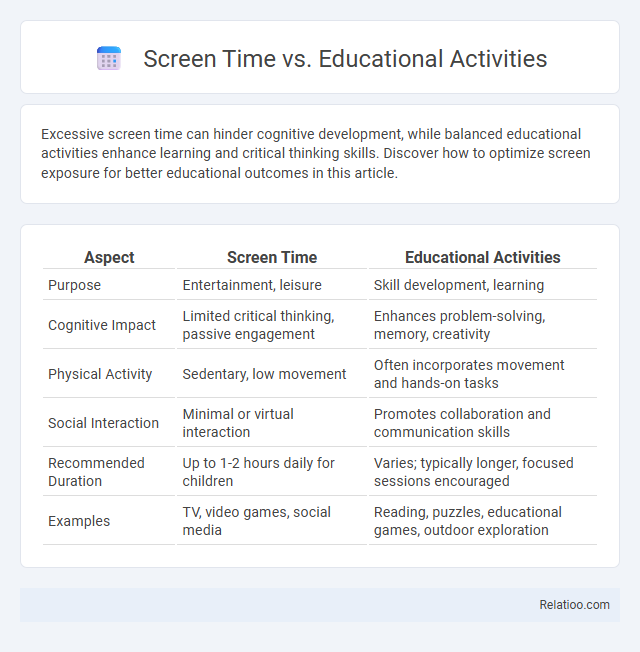Excessive screen time can hinder cognitive development, while balanced educational activities enhance learning and critical thinking skills. Discover how to optimize screen exposure for better educational outcomes in this article.
Table of Comparison
| Aspect | Screen Time | Educational Activities |
|---|---|---|
| Purpose | Entertainment, leisure | Skill development, learning |
| Cognitive Impact | Limited critical thinking, passive engagement | Enhances problem-solving, memory, creativity |
| Physical Activity | Sedentary, low movement | Often incorporates movement and hands-on tasks |
| Social Interaction | Minimal or virtual interaction | Promotes collaboration and communication skills |
| Recommended Duration | Up to 1-2 hours daily for children | Varies; typically longer, focused sessions encouraged |
| Examples | TV, video games, social media | Reading, puzzles, educational games, outdoor exploration |
Understanding Screen Time: Definition and Trends
Screen time refers to the amount of time you spend using devices such as smartphones, tablets, computers, and televisions, often categorized into recreational and educational activities. Understanding current trends reveals that balanced screen time, with a focus on educational content, can enhance learning outcomes while excessive recreational screen time may negatively impact cognitive and physical health. Experts recommend monitoring and optimizing your screen exposure to support overall well-being and effective learning experiences.
Educational Activities: Key Benefits for Child Development
Educational activities provide structured learning experiences that enhance cognitive skills, improve memory retention, and foster critical thinking in children. Screen time, when balanced and integrated with educational content, can support pedagogical goals by offering interactive and engaging learning opportunities. Prioritizing educational activities over passive screen use ensures children develop essential skills such as problem-solving, creativity, and effective communication.
The Impact of Excessive Screen Time on Learning
Excessive screen time negatively affects learning by reducing attention span, impairing memory retention, and limiting critical thinking development in children and adults alike. You benefit from balancing screen time with educational activities that promote active engagement, problem-solving, and creativity to enhance cognitive skills. Research shows that setting daily screen limits and encouraging interactive learning tools significantly improve academic performance and overall mental well-being.
Balancing Digital Devices and Traditional Learning
Balancing screen time and educational activities is essential for optimizing your child's learning and development. Excessive screen time can hinder attention spans and physical health, while integrating traditional learning methods like reading and hands-on activities supports cognitive growth and creativity. Establishing clear boundaries ensures that digital devices complement rather than replace vital educational experiences.
Screen Time Guidelines for Different Age Groups
Screen time guidelines recommend limiting exposure based on age to balance educational activities and leisure use effectively. For children under 2 years, screen time should be minimal with a focus on interactive educational content, while children aged 2 to 5 years are suggested to have no more than one hour per day of high-quality educational screen time. School-aged children and adolescents should follow guidelines of 1-2 hours of purposeful screen use daily, emphasizing educational and creative activities to support cognitive development and limit passive consumption.
Cognitive Effects: Screen Time vs. Educational Engagement
Excessive screen time can negatively impact your cognitive development by reducing attention span and memory retention, while educational activities stimulate critical thinking and problem-solving skills. Engaging in educational content during screen time enhances learning outcomes by promoting active participation and information processing. Balancing screen time with educational engagement optimizes cognitive effects, supporting better brain health and academic performance.
Strategies to Reduce Screen Time in Children
Balancing screen time and educational activities is crucial for your child's development, as excessive screen exposure can hinder attention span and cognitive growth. Implementing strategies such as setting consistent daily limits, encouraging outdoor play, and promoting interactive learning alternatives can effectively reduce screen time. Prioritizing these approaches supports healthier habits while fostering educational engagement and social interaction.
Incorporating Educational Apps: Pros and Cons
Incorporating educational apps into screen time offers interactive learning experiences that can enhance your child's cognitive skills and foster engagement through multimedia content. Benefits include personalized learning paths and immediate feedback, yet excessive use may lead to reduced physical activity and potential eye strain. Balancing screen time with hands-on educational activities ensures a holistic development approach, maximizing the advantages of digital tools while minimizing drawbacks.
Parental Role in Monitoring Screen and Learning Activities
Parental role in monitoring screen time and educational activities is crucial for balancing children's digital exposure and learning outcomes. Effective supervision involves setting clear limits on recreational screen use while encouraging interactive, educational content that promotes cognitive development. Implementing structured schedules and engaging in co-viewing can enhance learning experiences and mitigate negative effects of excessive screen time.
Creating a Healthy Daily Routine: Tips for Families
Balancing screen time with educational activities is essential for fostering a healthy daily routine in families, ensuring children engage in both interactive learning and recreational screen use without excess. Setting clear limits, such as no more than one to two hours of screen time per day, promotes attention span and encourages active learning through reading, hands-on projects, and physical play. Incorporating scheduled breaks and screen-free zones helps reduce eye strain and supports better sleep patterns, creating a well-rounded and productive daily schedule.

Infographic: Screen time vs Educational activities
 relatioo.com
relatioo.com